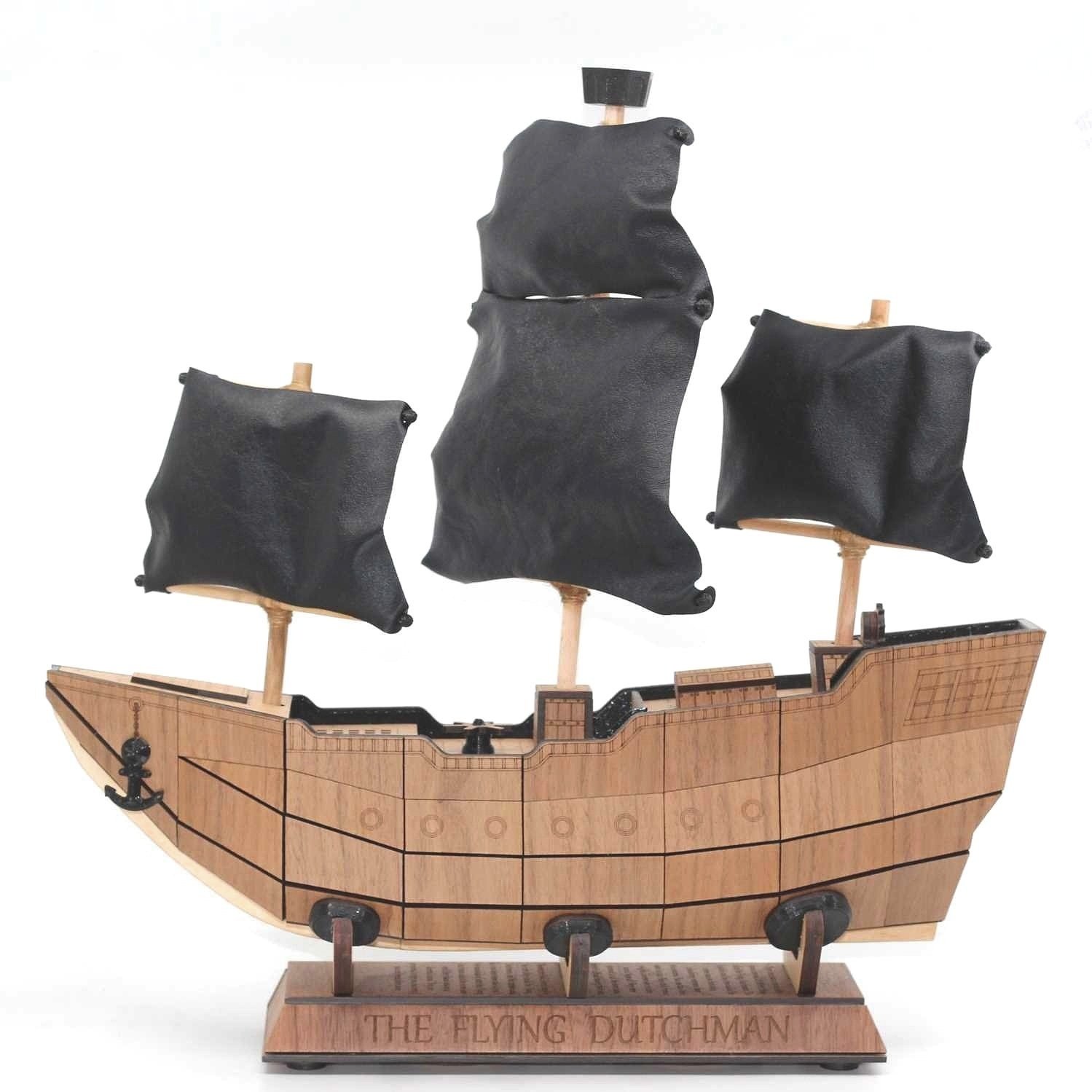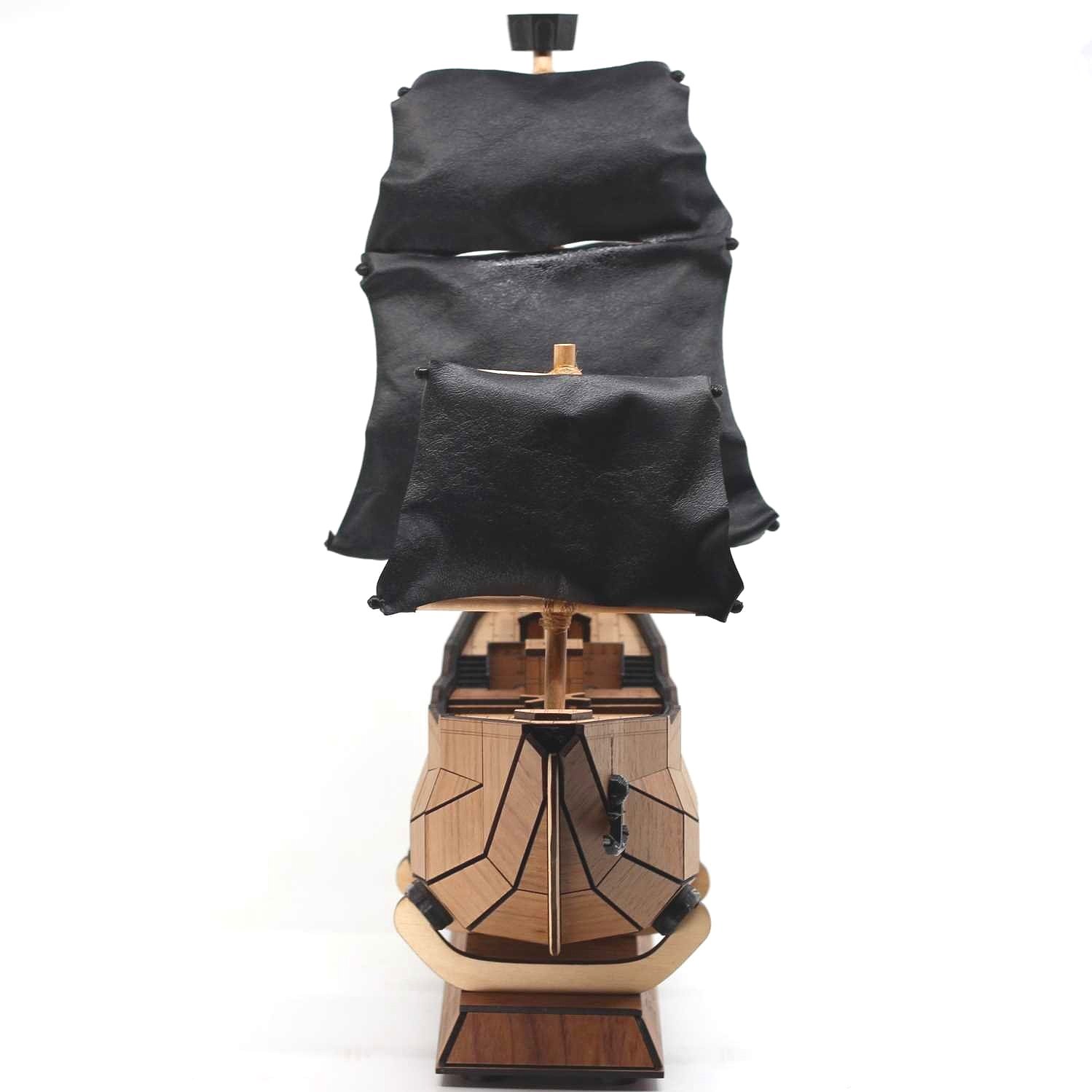Adventure on the High Seas
The Flying Dutchman
The Flying Dutchman by Benno de Grote
“De Vliegende Hollander” is a myth, a legend, a ghost story from the seventeenth century era when the Dutch East India Company controlled commerce on the seven seas. The ill-fated “Dutchman” could not make harbor due to stormy weather and was lost, with captain and crew doomed to roam the oceans forever. Sighting the phantom ship was never a good sign, although many lived to tell the tale.
curse averse?
Dutch puzzle wunderkind Benno “de Grote” has channeled the legend into his most epic creation yet, a magnificently mysterious Man-of-War which will transport you on a magical nautical adventure. He outlines the story and tasks you, a desperate castaway stuck on a remote island, with helping the doomed crew to locate a secret map hidden somewhere on the ship, which is the key to lifting the centuries long curse. Succeed, and they will rescue you, from the island, but also from your own puzzling despair at short lived, single goal and simple adventures – a fair exchange indeed. Along the way there is much to discover, with the sequential discovery of tools and tricks, hidden compartments, sub plots with many types of puzzles to solve, and many steps ‘ere the curse is lifted. As if this wasn’t enough to satisfy the hardiest of seafaring puzzlers, the ship is absolutely gorgeous, a true showpiece to display proudly.
helm from hell … mmm?
Benno relates the tale: “The Flying Dutchman is by far the biggest puzzle project I’ve ever made. I started toying with the idea for the Flying Dutchman well over two years ago. I’ve been trying to slowly change the way I design puzzles by stepping out of my comfort zone each time. This started when I finally got my own laser cutter which I used to make the Chess box (although I did make puzzles before that, I consider it my first professionally looking puzzle). After that I started to experiment more with combining basic shapes to make something that wouldn’t look like a simple cube, which resulted in the Small Cabin. The next step was making curved shapes which resulted in the Windmill. Based on the experiences I learned along the way I wanted three things for the Flying Dutchman.
prototyping display bases
photo courtesy of Benno de Grote
It should look good on a shelf and catch your eye.
Solving the puzzle should feel like an adventure.
It should challenge me to become better in making oddly shaped puzzles.
final working ship prototype
photo courtesy of Benno de Grote
While making the Windmill and the Small Cabin I got really into the sequential discovery theme. One of the things I like most about puzzles is when something surprises you. Don’t get me wrong, I love making complex mechanisms which need some brain power to solve, but I also like it when you’re fidgeting with a puzzle and suddenly something comes off. When making the Flying Dutchman I tried to combine these two to create a puzzle experience with also some surprises along the way. I also had some trouble with balancing the amount of hints the boat gives you to solve some of the puzzles. These were originally not included which made the puzzle a little too frustrating for some. I think the Flying Dutchman has a more diverse puzzle experience than most people would suspect. … I don’t want to spoil the feeling of discovery when you stumble upon something new. Given that it’s an expensive puzzle, I hope people will give me the benefit of the doubt when they see the puzzle.”
all hands on deck
Indeed the Dutchman is full of surprises! It is not a simple “puzzle box”, but rather a multi-step multiple puzzle genre adventure reminiscent of another mythical transportation device but on a grander scale. If you have experienced any of Benno’s prior puzzling creations, you will be prepared for many confusing conundrums along the way. He has a brilliantly complex mind and can create incredibly daunting challenges. His recent creations have been designed to be difficult but solvable and strike a reasonable balance. You might say he navigates these waters well. He also understands that people may be hesitant to invest in this new adventure, so he was willing to divulge a few more specifics which may help people decide. “Counting the amount of steps is a bit hard because some of the sub puzzles have multiple steps. I think I would say the puzzle has at least 14 steps, and 4 of those steps are a burr puzzle [what would be considered a TIC], a small maze, a small puzzle box with a celtic knot on the side and an edge match puzzle. The rest of the 10 steps are more sequential discovery. Some of the 10 steps could be seen as multiple steps. There are also two bonus compartments which are easy to find but are not included in the steps.” Benno is being modest in his description. There is plenty here to keep the hardiest of sailors busy for a while - this is a long distance journey. The surprising discoveries are like side trips and weave independent puzzles in with ciphers crucial for the goal. I am still trying to find my way to the final treasure - perhaps I should go easy on the rum ration.
take a bow, Benno
He has also crafted an impressive piece of art. The ship is large and heavy, featuring many fine details which invite exploration and reward observation. Before long you will be surrounded by an ever growing pile of parts and pieces, some helpful, and others purely whimsical. Mysterious discoveries emerge, encrypted with etchings with secrets secured inside. Batten down the hatches, you are in for a long journey.
final shape prototype
photo courtesy of Benno de Grote
“I wasn’t expecting how hard it was to make the shape of the puzzle feel realistic. I think I’ve worked on it for over 500 hours, redesigning the shape around 10 times. I wanted it to look like an archetype Flying Dutchman.” Benno explains that in order to make the ship look “realistic” and meet expectations he had to alter the appearance away from what a true Dutch fluyt cargo ship would actually look like and modify it to match what people might imagine.
final size prototype, 3D print
photo courtesy of Benno de Grote
“For instance, real ships are a lot narrower from side to side. This made the ship look smaller than intended, and gave me less room to work with on the inside. So, I increased it until it looked more “realistic”. In the end it took me an estimated 1500 hours of work until I finally settled on my last prototype. I can’t show most of the prototyping because it would spoil some of the puzzle elements, but I’ve included some iterations of the base and the ship. I’ve also included a small 3D print of the final shape I settled on, and a picture of the 3D print which I used to pick the right size for the ship (I also used it to test which kinds of glue work best to glue wood and PLA).”
ship shape
As you explore this ship you quickly understand that it contains many types of materials and has been built in a very creative way to maximize form and function while retaining a certain appearance. “The biggest challenge for this puzzle was getting the shape of the Hull right. It was also quite tricky to pack everything inside the Hull while still maintaining structural integrity. I originally wanted to make the entire ship out of wood, but that resulted in only a small amount of space for puzzles on the inside. I finally settled on 3D printing the inside and gluing the wood onto the PLA. This is something new I had never done and it allows more options for the shape while still looking good on the outside. Another challenge was getting the sails to look like they were catching wind. I experimented with a lot of different materials before settling on leatherette with multiple layers of varnish on the inside.” The varied materials used on the Dutchman include walnut, birch, and beech woods, transparent dark green acrylic, various colors of PLA, leatherette, and neodymium.
a stern look
Fans of Benno de Grote may be familiar with his many mass produced puzzle boxes such as the Companion Box, the Button Box, the Answer Box, the Prison Box, and many other recognizable laser cut puzzle boxes found on retail sites, the plans for which he has contracted out to various production companies. He is prolific at inventing these one-off basic puzzle boxes, but he also loves diving deep into something more complex, that tells a story and takes the solver on an adventure. “I also wanted a story around the puzzle, which is the pirate curse. I personally think it helps with the adventure feeling while solving the puzzle. I really like adding the acrylic figures which make the ship feel more alive. My personal favorite is the farmer, which will probably keep popping up in future puzzles I think O:).” That poor farmer can’t get a break, having been abducted by aliens, only to be trapped in a Windmill! “I hope you liked the adventure! Good luck with saving the captain and his crew from their terrible curse!”
Kaimana Cocktail (The Power of the Sea) by Jen Ackrill
Let’s raise our tankards to this accursed, amazing creation with a satisfyingly seaworthy toast. Bartender Jen Ackrill helms the ship at Hau Tree, the beach bar at the Kaimana hotel in Waikiki, where she oversees … overseas. Jen has a fondness for classic cocktails which she updates with locally sourced inspiration from her new home in Hawaii. Like the best stewards in hospitality, she knows to “give em what they want”, but would love it if what they want is one of her signature creations.
harnessing the power
Such as the Kaimana Cocktail, the hotel’s namesake drink. The cocktail is a classic gin sour that features a special type of citrus. Calamansi is a sour lemon-lime fruit indigenous to the Philippines, a hybrid combination of citrus and kumquat. Calamansi fruit look like limes on the outside, but have orange flesh inside. Full of refreshingly tart citrus, the cocktail would be welcome aboard any seventeenth century ship as an antiscorbutic, but I chose the cocktail in particular for the name. Kaimana, which is generally understood as “diamond”, can also be translated as “Power of the Sea”. Here’s to powerful adventures, from sea to shining sea. Cheers!
this pair is ship shape
Kaimana Cocktail by Jen Ackrill
1 ½ oz gin
1 ½ oz calamansi
1 ½ oz maraschino liqueur
¾ oz apricot liqueur
¾ oz lemon
Egg white
barspoon absinthe
Dry shake ingredients to aerate the shake with ice to chill. Strain into a favorite glass with fresh ice. Edible flower garnish recommended.
explore more:














